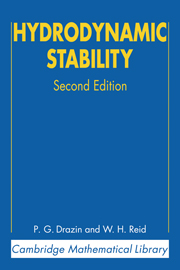Book contents
- Frontmatter
- Contents
- Foreword by John Miles
- Preface
- 1 INTRODUCTION
- 2 THERMAL INSTABILITY
- 3 CENTRIFUGAL INSTABILITY
- 4 PARALLEL SHEAR FLOWS
- 5 UNIFORM ASYMPTOTIC APPROXIMATIONS
- 6 ADDITIONAL TOPICS IN LINEAR STABILITY THEORY
- 7 NONLINEAR STABILITY
- APPENDIX: A CLASS OF GENERALIZED AIRY FUNCTIONS
- Addendum: Weakly non-parallel theories for the Blasius boundary layer
- Solutions
- Bibliography and author index
- Motion picture index
- Subject index
Foreword by John Miles
Published online by Cambridge University Press: 06 August 2010
- Frontmatter
- Contents
- Foreword by John Miles
- Preface
- 1 INTRODUCTION
- 2 THERMAL INSTABILITY
- 3 CENTRIFUGAL INSTABILITY
- 4 PARALLEL SHEAR FLOWS
- 5 UNIFORM ASYMPTOTIC APPROXIMATIONS
- 6 ADDITIONAL TOPICS IN LINEAR STABILITY THEORY
- 7 NONLINEAR STABILITY
- APPENDIX: A CLASS OF GENERALIZED AIRY FUNCTIONS
- Addendum: Weakly non-parallel theories for the Blasius boundary layer
- Solutions
- Bibliography and author index
- Motion picture index
- Subject index
Summary
The study of hydrodynamic stability goes back to the theoretical work of Helmholtz (1868), Kelvin (1871) and Rayleigh (1879, 1880) on inviscid flows and, above all, the experimental investigations of Reynolds (1883), which initiated the systematic study of viscous shear flows. Reynolds's work stimulated the theoretical investigations of Orr (1907) and Sommerfeld (1908), who independently considered small, traveling-wave disturbances of an otherwise steady, parallel flow and derived (what is now known as) the Orr–Sommerfeld equation.
Early attempts to solve the Orr–Sommerfeld equation for the flow associated with the uniform, relative motion of two parallel plates (plane Couette flow) led to the prediction of stability for all Reynolds numbers, in apparent disagreement with experiment (although the prediction is correct for infinitesimal disturbances). G. I. Taylor (1923), referring to this work, remarked that:
This problem has been chosen because it seemed probable that the mathematical analysis might prove comparatively simple; but … it has actually proved very complicated and difficult. [Moreover] it would be extremely difficult to verify experimentally any conclusions which might be arrived at in this case, because of the difficulty of designing apparatus in which the required boundary conditions are approximately satisfied.
It is very much easier to design apparatus for studying the flow of fluid under pressure through a tube, or the flow between two concentric rotating cylinders. The experiments of Reynolds and others suggest that [for] flow through a circular tube, infinitely small disturbances are stable, while larger disturbances increase provided the speed of flow is greater than a certain amount. […]
- Type
- Chapter
- Information
- Hydrodynamic Stability , pp. xiii - xviiiPublisher: Cambridge University PressPrint publication year: 2004

